Thursday, April 23, 2020
China Just Launched Their Second Type 075 Assault Carrier—Here’s Why Everyone Is Worried Beijing just keeps rising. by Caleb Larson
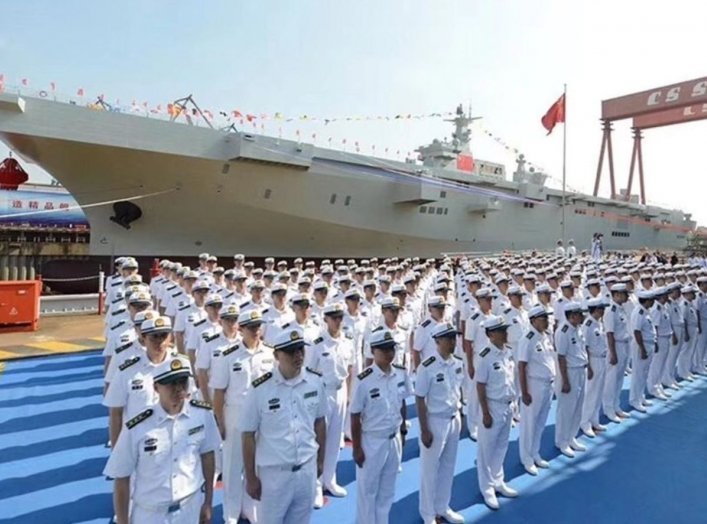
Despite limited experience, and in the midst of a global viral pandemic, China launched their second Type 075 class assault carrier—and it outclasses most other carriers in the region.
Type 075
China’s Type 075 is an amphibious assault ship that will be able to land PLA Navy marines and equipment in much the same way as the United States Wasp-class or America-class ships. It is also capable of helicopter operations and can reportedly house up to 30 attack helicopters.
In addition to the Type 075’s airborne capabilities, it has a floodable well deck that can launch and receive boats, hovercraft, or amphibious assault vehicles, potentially giving the new ship a potent ship-to-shore capability.
The Type 075 is huge—estimates put in the 35,000 to 40,000 ton range—and it easily outclasses other ships in the Indopacific region. The Type 075 is also significantly larger than the Type 071 that precedes it.
Fire in the Hole
The first of the Type 075 class apparently caught fire in early April while at port in Shanghai. Images on social media revealed the ship had been badly burned. Massive scorch marks were visible on the stern and appeared to lead into the well deck, implying that the fire had potentially originated (or possibly spread) into the belly of the ship. The fire, though seemingly large, was put out rather quickly, perhaps an indication that the fire had not spread as substantially as first appeared from online images.
What Virus?
Interestingly, the coronavirus pandemic has not seemed to slow construction down. The naval defense expert H. I. Sutton wrote that “defense analysts have been able to track progress on the carrier via candid photographs and overhead satellite imagery.”
Open-source intelligence has been one of the great boons of the internet age. He continued, “an analysis of crane movements in satellite images showed the level of work in the yard. It appears uninhibited by the coronavirus pandemic.”
Though the Type 075 certainly offers China new capabilities, the ship itself is not what is most impressive—the speed with which it was built is more incredible. Despite significantly less experience building amphibious carriers—and in the midst of a global pandemic—China is somehow able to launch a new carrier. A significant achievement, especially during peacetime.
Eyes on the Prize
The Type 075 carriers will likely be the People’s Liberation Army Navy workhorse for years, if not decades, to come. The Type 075 is also a clear demonstration of China’s increasing competency in building a truly blue-water fleet. China’s adversaries in the Indo-Pacific, and the South China Sea, will be watching intently.
Why the End of Kim Jong-un Won't Mean the End of North Korea Someone else might take power and want to avoid unification. by Jihwan Hwang
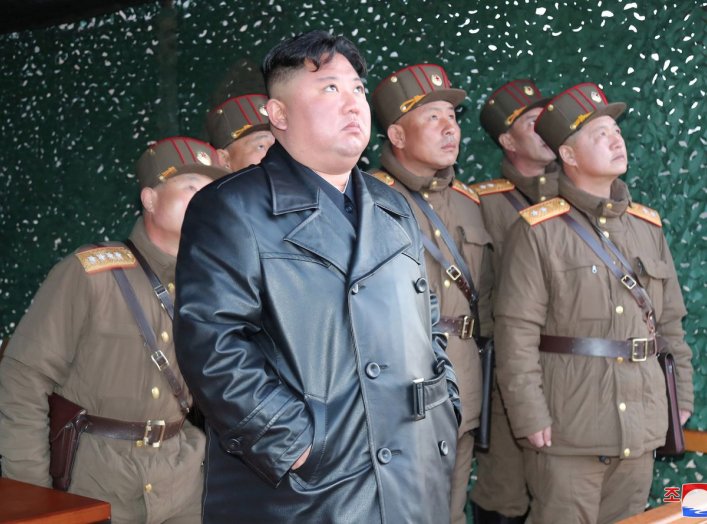
Many people may expect that North Korea would follow the case of East Germany if Kim Jong-un died suddenly. It appears, however, that the German model would be very difficult to realize because it is less likely to be supported by neighboring great powers and the North Korean people.
Rather, it is possible that a new leader or power group may rise after a series of fierce power struggles and replace the Kim Jong-un regime. If the North Korean domestic situation is stabilized, China and Russia would be more likely to approve of the new regime in North Korea. Because they would regard Kim’s sudden death as the collapse of the Kim Jong-un regime, not the collapse of North Korea as a nation, they are less likely to see Kim’s death lead to the unification on the Korean Peninsula and would support the rebuilding of a new regime in North Korea.
Even if a new leader does not emerge, the international community, mostly United Nations Security Council and neighboring powers, will have to cooperate on intervening politically to stabilize the North Korean domestic situation. Some may predict that Chinese troops may enter North Korea, but Beijing is less likely to intervene militarily because China does not want to be involved in a severe armed conflict against the United States. Also, China and Russia will insist on holding elections at the will of the North Korean people, just as other nations did after a regime collapse. It is doubtful, however, whether free elections would actually be held in North Korea, considering its unstable domestic political structure.
Even if a free and democratic election is held under the support of international community, the North Korean people are more likely to choose to build a new North Korea. To South Korea’s disappointment, there is no guarantee that the North Korean people will choose to achieve unification in the election. Although the East German people unexpectedly voted for the early unification with West Germany in the election of 1990, it is doubtful that the North Korean people will vote for a political group who insists on early unification with South Korea. It is also questionable whether a political group with a plan for early unification will emerge. The North Korean people will decide their own destiny, and it is not sure who they will vote for. According to an unofficial survey on the North Korean people conducted on the North Korea-Chinese border several years ago, most North Korean people are reported to have chosen to rebuild their own nation or cooperate with China rather than unify with South Korea.
This would be a shocking scenario to the South Korean people, but a more likely one that would happen. Even if Kim Jong-un died suddenly, North Korea will continue to exist as a nation in any case. A new leader or power group may emerge by force or a new political group will take power with the support of the North Korean people.
WHO: 'All Available Evidence' Points to Coronavirus' Animal Origins The WHO added that the virus "certainly" had an animal host, which was likely bats, although it remains uncertain exactly how the virus jumped from animals to humans. by Stephen Silver
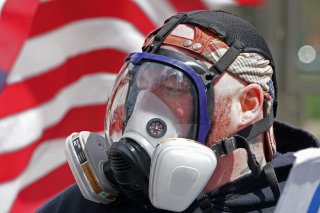
In recent weeks, there's been a great deal of speculation, even beyond the imaginations of conspiracy theorists, that the COVID-19 coronavirus may have escaped from a lab in China, rather than the more widely believed explanation that it originated from animals in or a near a wet market in the Wuhan region.
A pair of Washington Post columns earlier this month stated that some in the U.S. government believe that the virus may have accidentally leaked from a science lab in the Wuhan region. President Trump has even wondered aloud from the White House podium whether this theory is true. There is not, however, any hard evidence that such a thing happened, and scientists are virtually unanimous in believing that the virus could not possibly have been created intentionally.
However, Shi Zhengli, the internationally renowned virology scientist who is based at the Wuhan Institute of Virology, has "guaranteed with her own life" that the coronavirus did not come from her lab, and that the coronavirus does not match any of the disposal records at the Institute.
Now, the World Health Organization has weighed in on the question.
“All available evidence suggests the virus has an animal origin and is not manipulated or constructed in a lab or somewhere else,” WHO spokeswoman Fadela Chaib said this week at a news briefing in Geneva, as reported by Reuters. “It is probable, likely, that the virus is of animal origin.”
Chaib added that the virus "certainly" had an animal host, which was likely bats, although it remains uncertain exactly how the virus jumped from animals to humans.
The World Health Organization has itself become controversial in the age of coronavirus. The organization has been accused of acting too deferential to the Chinese government throughout the time that the coronavirus has been spreading, and also of uncritically repeating assertions of that government during the early days of the pandemic, and ignoring warnings by Taiwan.
Three New York residents have even sued WHO, in a proposed class action, for what they say is its role in the spread of the virus.
The president announced last week that the U.S. would suspend funding of the WHO, a decision that drew criticism from everyone from the U.S. Chamber of Commerce to health care activists. Some have argued that it’s unwise to take away such resources in the middle of a pandemic, while Democrats have stated that the president doesn't have the power to suspend the contributions, since the WHO funding has already been appropriated by Congress.
The World Health Organization, headquartered in Geneva is an agency of the United Nations. It is funded by a combination of governments and nonprofit organizations.
According to WeForum, citing the most recent figures from 2018, the U.S. is WHO's top funder, followed by the Bill and Melinda Gates Foundation, the governments of the U.K. and Germany, and the GAVI Alliance. And while various conspiracy theorists have argued that the WHO is "controlled by China," that country is only the organization's 16th-largest funder.
The WHO spokeswoman said in the briefing that the organization is 81 percent funded for the next two years.
No New Orders Issued: U.S. Military Brass Clarifies Trump’s Iran Threat “The President issued an important warning to the Iranians,” he told reporters at a Wednesday briefing. “What he was emphasizing is all of our ships retain the right of self-defense.” by Matthew Petti
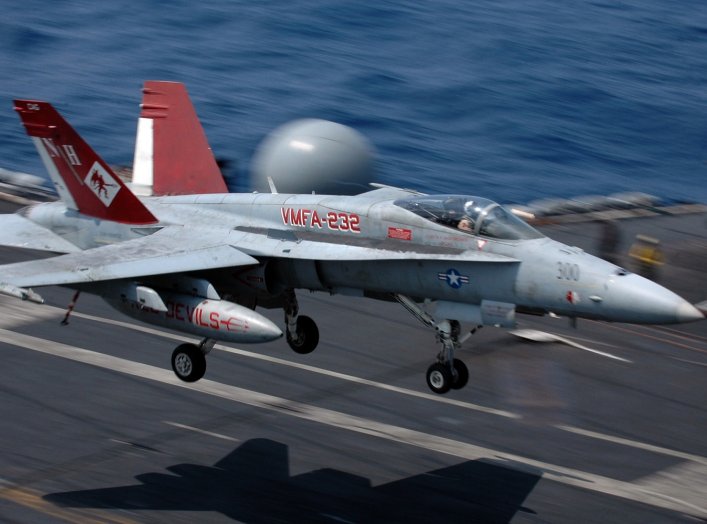
President Donald Trump’s social media message ordering the Navy to “shoot down and destroy” Iranian vessels was simply emphasizing that U.S. ships “retain the right of self-defense,” Deputy Defense Secretary David Norquist told reporters at the Pentagon.
The latest statements followed a tense showdown in the Persian Gulf between Iranian and U.S. vessels. The President has escalated against Iran without much warning, ordering the killing of Maj. Gen. Qassim Suleimani in a surprise airstrike in January. But he has also made statements that U.S. military leadership later walked back, including a January message on Twitter threatening to strike Iranian cultural sites.
“I have instructed the United States Navy to shoot down and destroy any and all Iranian gunboats if they harass our ships at sea,” Trump wrote on Twitter on Wednesday morning.
Norquist seemed to imply that Trump’s message was not a change in U.S. policy.
“The President issued an important warning to the Iranians,” he told reporters at a Wednesday briefing. “What he was emphasizing is all of our ships retain the right of self-defense.”
Iranian speedboats had spent an hour circling U.S. ships in the Persian Gulf last Thursday, making maneuvers towards their U.S. counterparts that U.S. Central Command called “dangerous and harassing.”
Iran initially claimed that the incident was in response to U.S. fighter jets attempting to breach Iranian airspace, a claim that U.S. Central Command denied to the National Interest.
Iranian naval commander Rear Admiral Alireza Tangsiri later claimed that “the Americans blocked the way for our vessels and refused to respond to the radio, which was met with a powerful confrontation by our forces.”
The Persian Gulf has seen a long history of incidents between the United States and Iran, including confrontations similar to last Thursday’s maneuvers. The two countries nearly went to war in July 2019 when Iran shot down a U.S. surveillance drone over the Gulf and Trump ordered retaliatory airstrikes.
Trump administration officials have made “restoring deterrence” the catchphrase of their policy towards Iran.
"Restoring deterrence is not static. It is a daily habit, and you've got to get that habit as part of your system, so we every day look for ways to get Iran to go back to its own borders," Brian Hook, the State Department official in charge of Iranian affairs, said at a February briefing.
U.S. officials at the Wednesday briefing also corroborated Iran’s claims to have launched the country’s first military satellite, although they did not confirm or deny whether the satellite was successfully put into orbit.
“What I can tell you is it went a very long way,” said Gen. John Hyten, vice chairman of the Joint Chiefs of Staff. “It has the ability once again to threaten their neighbors, our allies, and we want to make sure they can never threaten the U.S.”
Secretary of State Mike Pompeo said that Iran will be held “accountable” for the satellite launch at his own press conference.
France Plans to Reset Its Relationship With Russia. Will That Work? A deal to reduce the risk of the most catastrophic security scenario in Europe is in the interests of both sides. by John Deni
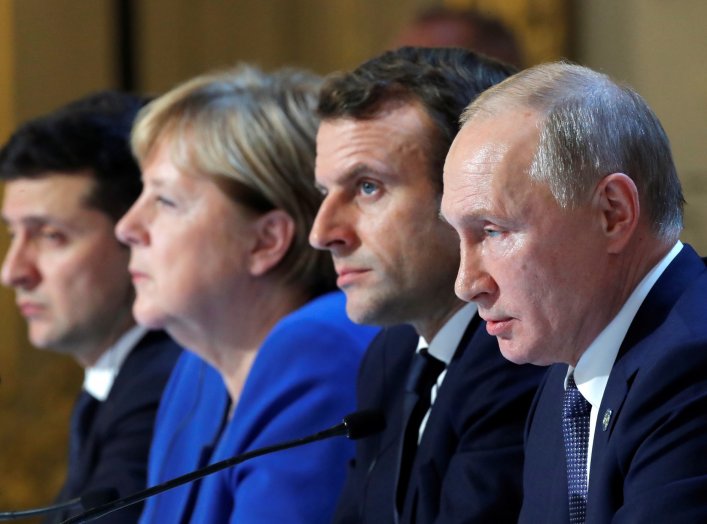
France is once again pushing for improved relations with Russia. During a meeting of European Union officials this week, France’s foreign minister, Jean-Yves Le Drian, pushed to broaden Europe’s engagement with Russia, and this came on the heels of February’s Munich Security Conference when French president Emmanuel Macron called for better long-term relations between Europe and Russia. The French are not alone in trying to get Europe toward some type of post-Crimea accommodation with Moscow—politicians in Hungary, Germany, Greece, and perhaps elsewhere would like to see relations with Russia return to normal. For that to happen though—and for Europe and the United States to end sanctions—Moscow would have to make some major concessions, given its forcible change of European borders in 2014. While it may seem unlikely, the shape of such a deal isn’t too difficult to flesh out—and the benefit of reduced tensions between Moscow and the West may be worth the effort.
From Russia’s perspective, a return to normal relations with the West would first mean an end to economic sanctions affecting banking and finance, the energy sector, and defense industrial trade. Macron claims these sanctions aren’t working, and he’s both right and wrong. Certainly, the sanctions haven’t caused Moscow to relinquish its hold on Crimea or end its intervention in the Donbas. Nonetheless, the sanctions—along with lower oil prices—have demonstrably and negatively affected the Russian economy. In part, as a result of economic stagnation, Russian president Vladimir Putin’s popularity has taken a hit. In sum, the sanctions have affected Russian power, both hard and soft, and Moscow is eager to end them.
If the West agreed to end the sanctions, would Putin agree to return Crimea to Ukraine? Probably not. But would Putin at least agree to leave the Donbas? Maybe so. Such an exchange—ending Western sanctions in exchange for Russia’s withdrawal from the Donbas—wouldn’t be an equal one for the West though. Acquiescing to Russia’s annexation of Crimea, even with Russian forces out of the Donbas, wouldn’t justify ending sanctions. After all, Russia didn’t just violate norms of behavior when it invaded and seized Crimea in 2014, it also broke international law and its own treaty commitments.
Macron’s efforts to engage Vladimir Putin and negotiate with Russia have yielded little in the way of results. The so-called Normandy Format of negotiations between the leaders of Ukraine, Russia, Germany, and France has restarted under Macron’s leadership, but there has been little progress so far. As a result, it is expected that the EU will soon approve another six-month extension of sanctions on Russia.
To achieve progress and get the West—much less Ukraine—to look the other way when it comes to Russia’s annexation of Crimea, Moscow would have to sweeten the deal significantly. It could start by ratcheting down Russia’s campaign of destabilization long underway across and over Eastern Europe. Specifically, Moscow could offer to denuclearize Kaliningrad, its exclave on the Baltic Sea sandwiched between Poland and Lithuania. Denuclearization would need to include the withdrawal of all Russian SSC-8 missile systems, which the United States and its NATO allies view as extraordinarily destabilizing due to its mobility. Over the last several years, Kaliningrad has seen a steady but gradual increase in nuclear infrastructure and related delivery systems like the SSC-8. To enforce all of this, Moscow would need to permit an inspection regime of some kind—luckily, the West and Russia have a long history of successfully negotiating and implementing intrusive arms control inspection arrangements.
Although turning down the temperature in Eastern Europe would need to start with Kaliningrad, it would also have to include other measures to increase stability and security. For instance, Moscow would need to stop violating the airspace of NATO allies and regional partners. It would need to end short-notice, large-scale exercises in areas near NATO and it would need to return to full compliance with confidence-building treaties it signed long ago. And it would need to stop and reverse its buildup of warships in the Black Sea.
Finally, even though there’s strong public support in Ukraine for ending the war in the Donbas, Kyiv is unlikely to get on board unless Moscow accedes to Ukraine’s desire for closer political, economic, and military ties with the West. Therefore, Russia would also need to verifiably end its support for the separatists in the Donbas and acknowledge Ukraine’s sovereignty in choosing its international relationships.
All of this sounds fantastically impossible today. Yet there are several reasons why offering the Russians a roadmap isn’t so crazy. First, with each passing year, it becomes more obvious that Russia is unlikely to relinquish Crimea. Kyiv and its friends in the West need to come to terms with this geopolitical reality, but at the same time they’d be foolish to roll over without getting something in return. The West ought to be explicit on its price.
Second, as suggested earlier, the impact of sanctions on the Russian economy may make Moscow increasingly more willing to negotiate a way out of the impasse. To do so, Moscow needs to understand what it will take to get the West and Ukraine to swallow the bitter pill of accepting Russian annexation of Crimea. It’s admittedly a high bar, but Moscow needs to know how high.
Third, Western solidarity—its center of gravity vis-à-vis Moscow—has long depended on offering Russia an open hand as well as a clenched fist. Dialogue and defense together formed NATO’s two-track path to security and stability throughout its seven decades. As the West increases defense spending and strengthens its military posture, it must simultaneously offer Russia a path forward, otherwise what today appears as minor fissures in Western unity could gradually become unbridgeable divides.
Make no mistake, this is not just another Western reset with Russia, which is a nonstarter in any case during this U.S. election year. None of what’s been suggested will address the ongoing gray zone war waged by Russia against the West, including media manipulation, election interference, aggressive cyber-attacks, and politically motivated assassinations. The West can and should continue its efforts to defend itself, strike back when and where appropriate, compete with Moscow across all domains and reduce Russia’s ability to threaten vital interests.
Just as arms control treaties of the 1970s and 1980s didn’t end spying between the United States and the Soviet Union or their proxy fights across the globe, solving the Ukrainian puzzle won’t turn Putin into a friend, or even a partner. Nonetheless, a deal to reduce the risk of the most catastrophic security scenario in Europe is in the interests of both sides.
Why China's Alleged Nuclear Testing Makes Case for Ratifying the Test Ban Treaty Leaving the treaty would only help China. by Gregory Kulacki

In April 15th, the U.S. Department of State released a report questioning China’s compliance with its moratorium on nuclear testing. It says activity at China’s nuclear weapons test site and a lack of transparency about those activities “raise concerns” about China’s adherence to the terms of the Comprehensive Nuclear Test Ban Treaty.
China and the United States, along with Russia, the United Kingdom and France, agreed not to conduct nuclear weapons tests banned by the treaty even though it has yet to enter into force. Russia, the United Kingdom, France and 165 other nations have ratified the treaty. China and the United States, along with North Korea, Egypt, Iran, India, Israel, and Pakistan have not. Those eight hold-outs must ratify the treaty before the full provisions of the CTBT can take effect.
Those provisions include comprehensive verification measures. If the CTBT were in effect today the concerns in the compliance report could be investigated through on-site inspections. China has repeatedly told the United States it will ratify the CTBT as soon as it has a chance to review any reservations the U.S. Senate might attach to America’s ratification vote. China’s been waiting for twenty-four years. The United States and China both signed the CTBT in 1996, but the one and only senate vote on ratification in October 1999 failed to muster the required two-thirds in favor.
How to Respond
Some U.S. senators argue the United States should respond to these new concerns about Chinese test site activity by withdrawing the U.S. signature from the CTBT and resuming testing. That’s a bad idea. China has far more to gain from renewed explosive nuclear testing than the United States.
China was only able to conduct 45 explosive nuclear weapons tests before signing the test ban treaty and agreeing to the voluntary moratorium; in comparison, the United States conducted 1,056 tests. This enormous U.S.–China testing gap is a considerable U.S. advantage. Preserving the test ban preserves that advantage.
Each nuclear test provides weapons designers with valuable data. But there are diminishing returns as testing continues. Chinese designers barely gained enough information from their limited testing program to reduce the mass of China’s nuclear warheads to a point where they could fit one each on China’s new road-mobile and submarine-launched ballistic missiles. Additional testing could help China further reduce the mass of its warheads, making it easier for China to put multiple warheads on its missiles. It would also allow China to produce a greater number of warheads from its limited supply of weapons-grade plutonium.
These two critical Chinese advances would vastly outweigh any benefits the United States might gain from a resumption of explosive nuclear testing. Keeping the moratorium in place and verifying Chinese compliance using the robust provisions of the CTBT would keep Americans safer.
Transparency and Trust
The United States and the rest of the world should ask questions about what China is doing at its nuclear test site in Lop Nor. But it may be no more than what the United States is doing at its test site in Nevada, where, to borrow the phrasing of the U.S compliance report on China, the U.S. nuclear weapons labs are “maintaining a high level of activity” and operating the Nevada test site “year round.”
Back in the 1990s, when China and the United States were negotiating the CTBT and considering ratification, the Chinese and U.S. nuclear weapons laboratories engaged in modest but regular exchanges that maintained confidence in their respective efforts to end testing. Had those exchanges continued, current U.S. questions about Chinese compliance and the work China is doing at Lop Nor might be a lot easier to answer.
This kind of transparency, which the compliance report rightfully notes is lacking, requires a modicum of mutual trust. Unfortunately, U.S.-China relations have deteriorated to the point where neither side is willing to engage the other on nuclear weapons issues. As a result, mutual suspicion and accusation are filling the void left by the lack of constructive dialog.
Arms Racing and Arms Control
Both China and the United States know from past experience that mutual suspicion fuels arms racing. Under its influence, the quest for balance and stability gives way to the search for advantage. U.S. and Chinese leaders are well aware that public accusations, like the one insinuated in the U.S. compliance report, increase acrimony and discourage dialog, especially when they’re unfounded. Left unchecked, mutual suspicion and repeated accusations will lock both nations into a negative spiral that will require extraordinary effort to escape.
China and the United States also know the search for military advantage, especially in nuclear armaments, is always fruitless. Every measure taken to gain a temporary advantage eventually produces a countermeasure to negate it. This is the reality on which nuclear arms control is based.
Welcome to Post-Coronavirus America: Epic Budget Battles and Circumvallating Crime Trends Await In Baltimore, the typically tainted budget tango that required two steps forward and yielded many more steps back played out privately behind closed doors while small pockets of chaos continued to spin across the city. The pandemic had created the worst of times under the most unusual of circumstances and there didn’t seem to be much of a pre-crisis plan for navigating its tumultuous uncertainties. by Maggie Ybarra

Society’s norms are based on repetition. The first sign of change to those norms can evoke a negative knee-jerk reaction because change is rarely embraced with affection. Quite often, change is the offspring of an unexpected affair—scorned and regarded with utter disdain. That’s why cultural changes are incremental, evolving over the span of decades and centuries. They get washed through a cycle of uprisings, violence, and litigation, only to get washed again. But once the coronavirus became a threat to mankind’s existence, they moved rapidly. People began wearing face masks after various state and city officials began to implement new public policies. Riding a bus required a mask. Ordering food at one of the few restaurants serving to-go orders required a mask. Solving crimes required a mask.

While politicians pontificated over the fate of their allotted territories in the face of upcoming elections, their constituents were quietly struggling to cope with the unknown future, hiding their uncertainties behind various swaths of cloth. There was nowhere for them to go but forward into the unknown unknowns, that void in the distance shaped and molded by the “things we do not know,” as former Defense Secretary Donald Rumsfeld once said. All of a sudden, Americans were thrust into the role of Eratosthenes and tasked with proving that their communities were capable of recovering from a worldwide deadly pandemic. Only instead of measuring the planet’s circumference, they would need to discover the shape of the future based on a series of experiments that would be constantly interrupted by the pitter-patter of little defeats.
City after city began experiencing a variety of growing pains. Some businesses adapted to the pandemic’s hardships while others were suspected of operating discreetly. Protests began erupting, sparking sharp clashes between two groups. There were those under duress from financial hardships and wanted their freedom to take health risks. Standing opposite them were those who had built their careers around science, the nurses who had spent day after day saving lives or watching people die.

In Baltimore, the norms quickly shifted for one part of society: the essential workers, bus drivers, grocery store cashiers, and police. But they were slower to shift for the city’s other citizens. Sometimes they were altogether shunned by those who had little respect for others before the country became embroiled in a global struggle to survive a deadly pandemic. On the streets, whether beneath the bright rays of the spring sun or wrapped in the cloak of the cold dark, police wore on their faces a white flag of surrender as they journeyed through the dangerous new territory that the coronavirus epidemic had created for them. A shooting here; a stabbing there; an ATM abducted in the middle of the night.

The sea of traumatic events continued to churn, pushed along by a slower undercurrent. But the hazards that typically lurked in its daunting abyss still comprised the worst parts of reality. Lingering among them were new political dangers, the cost of attempting to navigate through uncharted territory during a once-in-a-lifetime apocalyptic event. These threats made themselves more evident on April 9, after a meeting between city officials and local union leaders created new turmoil. The economic impacts of Baltimore’s wide-scale effort to protect its residents from the coronavirus were projected to create a revenue loss of $103 million in fiscal year 2021, which would need to be partially offset by one of three options that spanned from freezing the salaries of Baltimore’s police officers and firefighters or subjecting them to massive furloughs and layoffs.
The police union described the city’s “Choose Your Own Adventure” proposal as a “display of poor leadership” in a letter to its members.
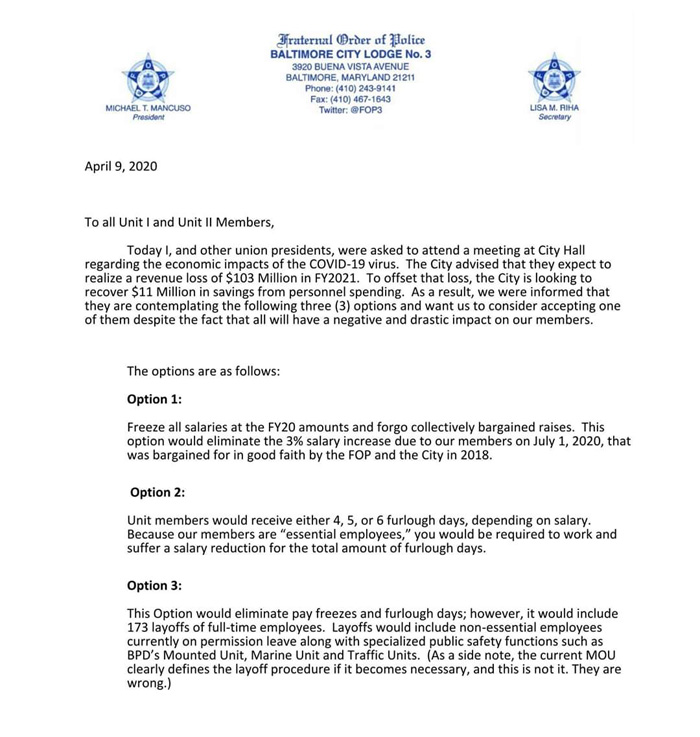

The firefighters’ union depicted the meeting as ill-timed and marred by preposterous suggestions. “We know that the City has to balance their budget with the Mayor and City Council by July and that everyone is being hit hard by this global pandemic,” union leaders said in a letter to firefighters. “But to suggest this sacrifice of our members who are on the front lines every day is unacceptable and disheartening.”


It was the typical tainted budget tango that required two steps forward and yielded many more steps back. While that intimate interaction proceeded to play out privately behind closed doors, small pockets of chaos continued to spin across the city. They surfaced and resurfaced amid the old mansions that had survived the uncertainties of the early twentieth century but succumbed to the homeless problems and drug addictions that became common at the end of the late twentieth century. They sprung up amid the abandoned houses of the city’s westside neighborhoods like tufts of dandelion, small, barely noticeable, and yet poised to populate its overlooked lots and unkempt alleyways. The unusual crimes that were the hallmark of the city had become the usual crimes of its pandemic period. On April 10, the day after city officials had tried to herd local union leaders toward a future of furloughs and layoffs, police officers were reeling from a twenty-four hour period where multiple ATMs had been stolen, mostly during business hours, and mostly with store employees standing by to witness the audacity of Baltimore’s brazen criminals. Then, on April 15, police stumbled across a new anomaly in an alleyway on the southwest side of the city: an abandoned truck, with its engine still running and its truck bed filled with ATM parts.

The daytime “get rich quick” ATM thefts had disappeared for a bit only to resurface amid Baltimore’s sea of sins on April 21. That’s when the criminals struck again. They targeted a small store seated four blocks away from one that was targeted before, in the same neighborhood, around the same time of day. What once had been an occasional overnight trend in the fall of 2019 had tentatively evolved into the daytime norm of spring 2020. The sharks known to lurk on the outskirts of the city’s shore were starting to explore the undercurrents in the shallow waters that had been made available to them by coronavirus restrictions, mauling and munching on whatever they could find. It was the tell-tale sign of adaptation in the test pool of a pandemic-panicked society.
No More Love from Trump: Is the Hydroxychloroquine Honeymoon Over? In recent days, multiple media outlets have noticed that both the president and Fox News have been mentioning hydroxychloroquine a lot less. by Stephen Silver
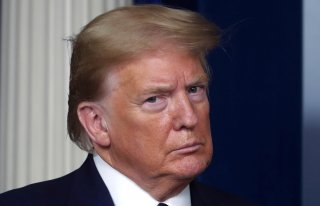
For several weeks in March and April, the debate over hydroxychloroquine had the feel of something like a culture war. President Trump repeatedly talked it up in press briefings, a sentiment echoed frequently by allies of the president in media and his administration. The debate over the effectiveness of the antimalarial drug, which has received approval for off-label use, in treating coronavirus has even reportedly led to contentious arguments within the president's own task force.
But in recent days, multiple media outlets have noticed that both the president and Fox News have been mentioning hydroxychloroquine a lot less.
Politico reported earlier this week that both the president and Fox News have "subtly scaled down their hyping of hydroxychloroquine as a potential cure for the coronavirus." As Monday, Trump hadn't mentioned the drug in a briefing since April 14. He's mostly avoided mentioning the treatment on social media, as well.
Meanwhile, the Fox News hosts who have most often talked up the drug, Tucker Carlson, Sean Hannity and Jeanine Pirro, appeared to avoid talking about hydroxychloroquine for the entire previous week.
The Daily Beast also noticed this week that Fox News has significantly cut back on on-air mentions of the treatment, noting that the drug had been mentioned on Fox News and Fox Business 51 times in the week that began April 15, compared with nearly 200 mentions the week before.
CNN also noted that Fox News has "fallen out of love with hydroxychloroquine."
The Associated Press reported Tuesday that a new preliminary study found that hydroxychloroquine "showed no benefit in a large analysis of its use in U.S. veterans hospitals," and that there were more deaths among those who were given the drug than those who received standard care.
The study, of 368 male veterans who were diagnosed with coronavirus at the Veterans Health Administration, was paid for with grants from the National Institutes of Health and the University of Virginia, and published to the online platform medRxiv. It was not a large-scale drug trial, nor was it peer-reviewed, but was the largest study to date of the effectiveness of the treatment on coronavirus patients.
The president was asked about the study in his briefing Tuesday. In response, per The Daily Beast, the president replied that "I don’t know of the report… obviously there have been some very good reports and perhaps this one’s not a good report—but we’ll be looking at it.”
Why America Fears Iran's So-Called 'Space Launches' (Think ICBMs) The Trump administration has long condemned Iran’s space program for a very clear reason: U.S. officials fear that Iran’s space program could be cover for an intercontinental ballistic missile (ICBM) program in addition to an intelligence threat. by Matthew Petti

The Iranian military claims to have put its first satellite into orbit in a surprise launch on Wednesday.
Iran has a history of failed launches in pursuit of a space program. The United States has long condemned these launches as attempts at developing the Iranian ballistic missile program. The launch on Wednesday—which has not yet been independently confirmed—came without any prior announcements.
The satellite was launched from a three-stage Qased carrier into a 425-kilometer orbit, Islamic Revolutionary Guard Corps (IRGC) commander Maj. Gen. Hossein Salami claimed. State-run news agencies carried images of the satellite launching but did not provide evidence that it had successfully attained the 425-kilometer orbit.
“Today, we can visualize the world from space, and this means extending the strategic intelligence of the powerful defense force, the IRGC,” he told the state-run Islamic Republic News Agency. “Today, the powerful armies of the world do not have a comprehensive defense plan without a presence in space, and attaining this superior technology that brings us to space and expands our range of capabilities is a strategic achievement.”
U.S. officials fear that Iran’s space program could be cover for an intercontinental ballistic missile (ICBM) program in addition to an intelligence threat.
The intelligence community told the Congressional Research Service in 2018 that “[p]rogress on Iran’s space program, such as the launch of the Simorgh SLV in July 2017, could shorten a pathway to an ICBM because space launch vehicles use similar technologies.”
However, the report to Congress also noted that “no country has developed an ICBM from its space launch technology base; space launch programs have generally developed from military ballistic missile programs.”
The State Department did not immediately respond to a request for comment, but it had condemned an earlier failed space launch on February 9, 2020.
“The technologies used to launch satellites into orbit are virtually identical and interchangeable with those used in longer-range systems, including intercontinental ballistic missiles,” Secretary of State Mike Pompeo said on February 11. “Each launch, whether failed or not, further allows Iran to gain experience using such technologies that could benefit its missile programs under the guise of a peaceful space program.”
He added that “[t]he world’s leading state sponsor of terrorism should not be allowed to develop and test ballistic missiles.”
Pompeo condemned his predecessors in the Obama administration for failing “to constrain testing that could support further advancement of Iran’s ballistic missile program” in a 2015 deal regulating Iran’s nuclear research.
The Trump administration left the 2015 deal two years ago, and has been applying a self-described campaign of “super-maximum economic pressure” in a bid to force additional concessions from Iran.
Iran’s politicians have also used the space program domestically to boost their nationalist credentials.
“Today ‘Zafar’ satellite launch failed. Like many scientific projects, Failure happened,” wrote Mohammad Javad Azari Jahromi, the country’s communications minister in an English-language social media post. “But We're UNSTOPPABLE! We have more Upcoming Great Iranian Satellites!”
He then apologized for attempting to pass off a photo of a children’s spaceman costume as an example of a future Iranian astronaut’s uniform.
“Today ‘Zafar’ satellite launch failed. Like many scientific projects, Failure happened,” wrote Mohammad Javad Azari Jahromi, the country’s communications minister in an English-language social media post. “But We're UNSTOPPABLE! We have more Upcoming Great Iranian Satellites!”
He then apologized for attempting to pass off a photo of a children’s spaceman costume as an example of a future Iranian astronaut’s uniform.
Who Takes Over if Kim Jong-un Dies? Rumors surrounding Kim’s health raise questions of what would happen should he pass away. Who would succeed him? What would happen with North Korea’s nuclear program? What would the impact be on inter-Korean and U.S.-North Korean relations? Would the regime collapse? While these questions are impossible to answer with 100 percent certainty, there are some clues we can look to. by Abby Bard
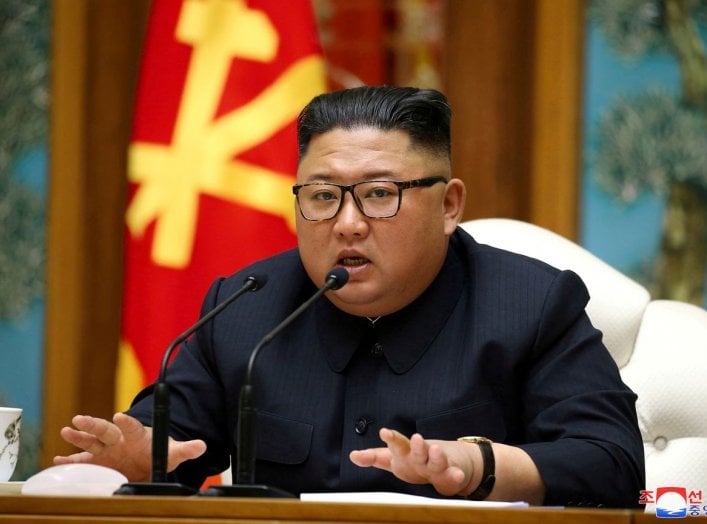
Over the last 48 hours, reports that the United States government is tracking intelligence that Kim Jong-un is “in grave danger” shook the North Korea watcher community. Suspicions that something may be off had grown in light of the 36-year old leader’s absence at Day of the Sun festivities, which celebrate the birth of his grandfather, on April 15.
This is not the first time that a lack of Kim sightings has led to reports of health problems. It is also unclear as to whether these rumors are well-founded. National Security Advisor Robert C. O’Brien says that the United States is unsure of Kim’s condition, while the South Korean government says there are no indicators that Kim is in poor health. While North Korea has yet to confirm any cases of COVID-19 within their country, it is not out of the question that Kim has taken a break from public appearances to avoid exposure to the virus.
Rumors surrounding Kim’s health raise questions of what would happen should he pass away. Who would succeed him? What would happen with North Korea’s nuclear program? What would the impact be on inter-Korean and U.S.-North Korean relations? Would the regime collapse? While these questions are impossible to answer with 100 percent certainty, there are some clues we can look to.
There is no current heir apparent, but any successor is likely to come from inside the Kim family. Kim has an older brother Kim Jong-chul, who was already passed over for the role of Supreme Leader in favor of the younger Kim. Additionally, Kim’s younger sister Kim Yo-jong has played an active role in her brother’s regime, but it would be unprecedented for a woman to head the country. Kim is reported to have three children who would be too young to lead, raising questions of whether some sort of regent scenario is possible. There is also the risk of a broader, potentially destabilizing power struggle.
Answers to questions related to nuclear weapons and relations with South Korea and the United States will depend on who comes to power, their ability to consolidate power, and who they rely on within North Korean society as their power base. These answers also won’t be immediately evident since dictators tend to operate on longer time horizons than democratically-elected leaders do. Moreover, a new North Korean leader will not necessarily present clear attitudes towards engagement or denuclearization on day one of their reign.
Whether or not Kim is actually in danger—and it is too early to tell whether these are rumors or something more—these are issues that the United States, South Korea, China, and the global community should be thinking in case he did (or ever does) pass away before a clear heir to the Kim dynasty is ascertained.
Subscribe to:
Comments (Atom)
What Will Happen if the Coronavirus Vaccine Fails? A vaccine could provide a way to end the pandemic, but with no prospect of natural herd immunity we could well be facing the threat of COVID-19 for a long time to come. by Sarah Pitt
There are over 175 COVID-19 vaccines in development. Almost all government strategies for dealing with the coronavirus pandemic are base...






